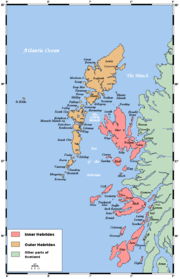Inner Hebrides
2008/9 Schools Wikipedia Selection. Related subjects: Geography of Great Britain
The Inner Hebrides ( Scottish Gaelic: Na h-Eileanan a-staigh - the inner isles) is an archipelago off the west coast of Scotland, to the south east of the Outer Hebrides. They are part of the Hebrides. In classical sources, they are referred to as the Ebudae or the Ebudes. Traditionally, the Inner Hebrides have been subdivided into two groups (northern and southern).
History
The Hebrides were settled early on in the settlement of the British Isles, perhaps as early as the Mesolithic era, around 8500-8250 BC, after the climatic conditions improved enough to sustain human settlement. There are examples of structures possibly dating from up to 3000 BC, the finest example being the standing stones at Callanish, but some archaeologists date the site as Bronze Age. Little is known of the people who settled in the Hebrides but they were likely of the same Celtic stock that had settled Scotland. Settlements at Northton, Harris, have both Beaker & Neolithic dwelling houses, the oldest in The Western Isles, attesting to the settlement.
Irish Gaels moved north and began to colonize the area sometime in the 4th or 5th Century. These people formed the Gaelic kingdom of Dal Riata. The golden age of Dal Riata is thought to be around near the beginning of the 7th Century and began a decline, with intermittent revivals occurring as late as the 9th Century.
Columba came to the Inner Hebrides in 563, founding a monastery on Iona and a number of other monasteries and retreats in the surrounding islands. The first written records of the islands began with the arrival of Columba.
The Hebrides began to come under Norse control and settlement already before the 9th century AD. The Norse control of the Hebrides was formalized in 1098 when Edgar of Scotland formally signed the islands over to Magnus III of Norway. The Scottish acceptance of Magnus III as King of the Isles came after the Norwegian king had conquered the Orkney Islands, the Hebrides and the Isle of Man in a swift and devastating campaign earlier the same year, directed against the local Norwegian leaders of the various islands after they had begun paying homage to Edgar as their overlord. By capturing the islands Magnus III subdued the Norsemen who had seized the islands centuries earlier and imposed a more direct royal control.
The Norwegian control of both the Inner and Outer Hebrides would see almost constant warfare until being ultimately resolved by the partitioning of the Western Isles in 1156. The Outer Hebrides would remain under the Kingdom of Mann and the Isles while the Inner Hebrides broke out under Somerled, the Norse-Celtic kinsman of both Lulach and the Manx royal house. Although the Inner Hebrides, from 1156 known as the Kingdom of the Hebrides, still nominally was under the sovereignty of Norway, the leaders were Scottish in language and culture rather than Norse.
After his victory of 1156 Somerled went on to two years later seize control over the Isle of Man itself and become the last King of the Isle of Man and the Isles to rule over all the islands the kingdom had once included. After Somerled's death in 1164 the rulers of Mann would no longer be in control of the Inner Hebrides.
The Lord of the Isles would continue to rule the Inner Hebrides as well as part of the Western Highlands as a subject of the King of Scots until John MacDonald, fourth Lord of the Isles, squandered the family's power away. Through a secret treaty with Edward IV of England in 1462, he planned to make himself more or less an independent ruler. When James III of Scotland found out about the treaty in 1475, he forfeited MacDonald's lands. Some were restored for a promise of good behaviour, but MacDonald was unable to control his son who defeated him at the Battle of Bloody Bay (Mull, 1481) and his nephew whose rebellion in 1493 provoked an exasperated James IV to forfeit the lands for the last time in 1493. MacDonald died in 1503.
Islands
Northern
The northern Inner Hebrides comprise Skye, the Small Isles and some smaller islands surrounding Skye. They are part of the Highland unitary council region. The smaller islands include:
- Ascrib Islands
- Crowlin Islands
- Isay
- Longay
- Ornsay
- Raasay
- Pabay
- Scalpay, Soay, South Rona
- Wiay
- Summer Isles
Southern
The southern Inner Hebrides comprise Mull, Islay, Jura, the Slate Islands, the Treshnish Islands and some islands surrounding Mull. They are part of the Argyll and Bute council region. The smaller islands include:
- Calve Island, Cara, Càrna, Coll, Colonsay
- Eileach an Naoimh, Eilean Dubh Mòr, Eilean Macaskin, Eilean Righ, Eorsa, Erraid
- Garbh Eileach, Gigha, Gometra, Gunna
- Iona, Inch Kenneth
- Kerrera
- Lismore, Little Colonsay, Luing, Lunga
- Oronsay
- Scarba, Seil, Shuna, Staffa
- Texa, Tiree
- Ulva
The Islands of the Clyde are sometimes mislocated in the Southern Hebrides. Technically they are not part of the archipelago.
Literature
- Ross, David (2005) Scotland - History of a Nation
